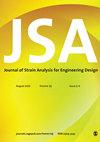Improving the tensile property calculations with plastic zone radius measurements in depth-sensing spherical indentation tests
IF 1.8
4区 工程技术
Q3 ENGINEERING, MECHANICAL
Journal of Strain Analysis for Engineering Design
Pub Date : 2021-09-04
DOI:10.1177/03093247211043982
引用次数: 3
Abstract
Depth-sensing spherical indentation tests (SITs) have been widely used in tensile property calculations, but the accuracy and reproducibility of calculations may be significantly influenced by displacement measurement errors. Taking two representative tensile property calculation methods as examples, namely the analytical and numerical methods, the rationale as to why accurate and reproducible tensile property calculations cannot be expected from the depth-sensing SITs was discussed in detail. Subsequently, the proportional limit σ0 calculation from plastic zone radius rp measurements, which was analytically developed in the expanding cavity model (ECM) and experimentally measured by digital image correlation (DIC), was introduced to enhance the accuracy and reproducibility of the two representative methods. Principles for setting the strain threshold εth were established, and factors influencing the σ0 calculation from rp measurements were investigated through the optical system, the friction condition, the hardening behaviors of specimen materials, and the indentation depth. Through finite element calculations, it was proven that tensile property calculations at the existence of displacement measurement errors, particularly the constant error from the origin correction, can be significantly improved with the introduction of rp measurements. Similar findings were also observed in experiments on four metals that exhibited different hardening behaviors.改进深度感测球形压痕试验中塑性区半径测量的拉伸性能计算方法
深度传感球形压痕试验(sit)在拉伸性能计算中得到了广泛的应用,但位移测量误差会显著影响计算的准确性和再现性。以解析法和数值法两种具有代表性的拉伸性能计算方法为例,详细讨论了深度传感sit无法准确再现拉伸性能计算的基本原理。在此基础上,通过扩展腔模型(ECM)解析推导和数字图像相关(DIC)实验测量的塑性区半径rp的比例极限σ0计算,提高了两种代表性方法的精度和再现性。建立了应变阈值εth的设定原则,并从光学系统、摩擦条件、试样材料的硬化行为和压痕深度等方面研究了rp测量结果中σ0的影响因素。通过有限元计算证明,引入rp测量后,存在位移测量误差的拉伸性能计算,特别是原点校正的恒定误差可以得到显著改善。在四种表现出不同硬化行为的金属的实验中也观察到类似的结果。
本文章由计算机程序翻译,如有差异,请以英文原文为准。
求助全文
约1分钟内获得全文
求助全文
来源期刊

Journal of Strain Analysis for Engineering Design
工程技术-材料科学:表征与测试
CiteScore
3.50
自引率
6.20%
发文量
25
审稿时长
>12 weeks
期刊介绍:
The Journal of Strain Analysis for Engineering Design provides a forum for work relating to the measurement and analysis of strain that is appropriate to engineering design and practice.
"Since launching in 1965, The Journal of Strain Analysis has been a collegiate effort, dedicated to providing exemplary service to our authors. We welcome contributions related to analytical, experimental, and numerical techniques for the analysis and/or measurement of stress and/or strain, or studies of relevant material properties and failure modes. Our international Editorial Board contains experts in all of these fields and is keen to encourage papers on novel techniques and innovative applications." Professor Eann Patterson - University of Liverpool, UK
This journal is a member of the Committee on Publication Ethics (COPE).
 求助内容:
求助内容: 应助结果提醒方式:
应助结果提醒方式:


